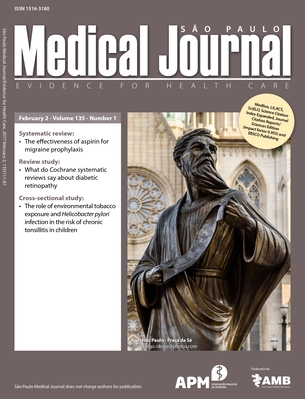Síndrome de Boerhaave – relato de caso
Palavras-chave:
Esôfago, Ruptura espontânea, Hematêmese, Pneumotórax, EnfisemaResumo
CONTEXTO: A síndrome de Boerhaave é uma ruptura longitudinal transmural espontânea do esôfago, normalmente da parte distal. Ela geralmente se desenvolve durante ou após vômitos persistentes como consequência do aumento repentino da pressão intraluminal no esôfago. É extremamente rara na prática clínica. Em 50% dos casos, manifesta-se pela tríade de Mackler: vômitos, dor torácica inferior, enfisema subcutâneo. Hematêmese é uma apresentação incomum porém desafiadora da síndrome de Boerhaave. Em comparação com rupturas de outras partes do tubo digestivo, a ruptura espontânea é caracterizada pela taxa de mortalidade mais elevada. RELATO DO CASO: O artigo apresenta uma paciente do sexo feminino de 64 anos de idade, cujo vômito era preto, quatro dias antes do exame, e continha sangue no dia do exame. Os sintomas incluíam dor epigástrica e sufocação. No exame físico, foi verificada hipotensão, taquicardia, dispneia e abdômen inchado e doloroso. Ausculta revelou estertores laterais na inspiração. A ultrassonografia mostrou estômago dilatado, preenchido com conteúdo líquido. Sucção nasogástrica evacuou mais de 1.000 ml de sangue fresco. Esofagogastroduodenoscopia foi abortada imediatamente ao se entrar no esôfago proximal, onde foi observada grande quantidade de sangue fresco. A paciente foi encaminhada com urgência para cirurgia abdominal, durante a qual faleceu. Autópsia estabeleceu diagnóstico de síndrome de Boerhaave e úlcera no bulbo-duodenal. CONCLUSÃO: A síndrome Boerhaave deve ser considerada em todos os casos com uma ombinação de sintomas gastrointestinais (especialmente dor epigástrica e vómitos) e sintomas e sinais pulmonares (especialmente sufocação).
Downloads
Referências
Dellon ES, Shaheen NJ. Miscellaneous diseases of the esophagus: foreign bodies, physical injury and systemic and dermatological diseases. In: Yamada T, editor. Textbook of Gastroenterology. 5th ed. Chichester: Blackwell Publishing: 2009. p. 871-88.
Brinster CJ, Singhal S, Lee L, et al. Evolving options in the management of esophageal perforation. Ann Thorac Surg. 2004;77(4):1475-83.
Garas G, Zarogoulidis P, Efthymiou A, et al. Spontaneous esophageal rupture as the underlying cause of pneumothorax: early recognition is crucial. J Thorac Dis. 2014;6(12):1655-8.
Venø S, Eckardt J. Boerhaave's syndrome and tension pneumothorax secondary to Norovirus induced forceful emesis. J Thorac Dis. 2013;5(2):E38-40.
Reardon ES, Martin LW. Boerhaave's syndrome presenting as a mid-esophageal perforation associated with a right-sided pleural effusion. J Surg Case Rep. 2015(11). pii: rjv142.
de Schipper JP, Pull ter Gunne AF, Oostvogel HJ, van Laarhoven CJ. Spontaneous rupture of the oesophagus: Boerhaave's syndrome in 2008. Literature review and treatment algorithm. Dig Surg. 2009;26(1):1-6.
Roy PK, Murphy ME, Kalapatapu V, Bashir S, Mujibur R. Boerhaave Syndrome. Medscape. Available from: http://emedicine.medscape.com/article/171683 Accessed in 2016 (Sep 8).
Tsalis K, Vasiliadis K, Tsachalis T, et al. Management of Boerhaave's syndrome: report of three cases. J Gastrointestin Liver Dis. 2008;17(1):81-5.
Yang ST, Devanand A, Tan KL, Eng PC. Boerhaave's syndrome presenting as a right-sided pleural effusion. Ann Acad Med Singapore. 2003;32(3):415-7.
Fikfav V, Gaur P, Kim MP. Endoscopic management of Boerhaave's syndrome presenting with hematemesis. J Surg Case Rep. 2014(11). pii:rju110.
Søreide JA, Viste A. Esophageal perforation: diagnostic work-up and clinical decision-making in the first 24 hours. Scand J Trauma Resusc Emerg Med. 2011;19:66.
Woo KM, Schneider JI. High-risk chief complaints I: chest pain--the big three. Emerg Med Clin North Am. 2009;27(4):685-712, x.
Eckstein M, Sean O. Henderson. Thoracic trauma, esophagus perforation. In: Marx J A, ed. Rosen's Emergency Medicine. Concepts and Clinical Practice. 8th ed. Philadelphia: Mosby; 2014. p. 455-8.
Kollmar O, Lindemann W, Richter S, et al. Boerhaave's syndrome: primary repair vs. esophageal resection--case reports and meta-analysis of the literature. J Gastrointest Surg. 2003;7(6):726-34.
Duman H, Bakirci EM, Karadag Z, Ugurlu Y. Esophageal rupture complicated by acute pericarditis. Turk Kardiyol Dern Ars. 2014;42(7):658-61.
Vial CM, Whyte RI. Boerhaave's syndrome: diagnosis and treatment. Surg Clin North Am. 2005;85(3):515-24, ix.
Arantes V, Campolina C, Valerio SH, et al. Flexible esophagoscopy as a diagnostic tool for traumatic esophageal injuries. J Trauma. 2009;66(6):1677-82.
Huber-Lang M, Henne-Bruns D, Schmitz B, Wuerl P. Esophageal perforation: principles of diagnosis and surgical management. Surg Today. 2006;36(4):332-40.
Schweigert M, Beattie R, Solymosi N, et al. Endoscopic stent insertion versus primary operative management for spontaneous rupture of the esophagus (Boerhaave syndrome): an international study comparing the outcome. Am Surg. 2013;79(6):634-40.
Downloads
Publicado
Como Citar
Edição
Seção
Licença

Este trabalho está licenciado sob uma licença Creative Commons Attribution 4.0 International License.





